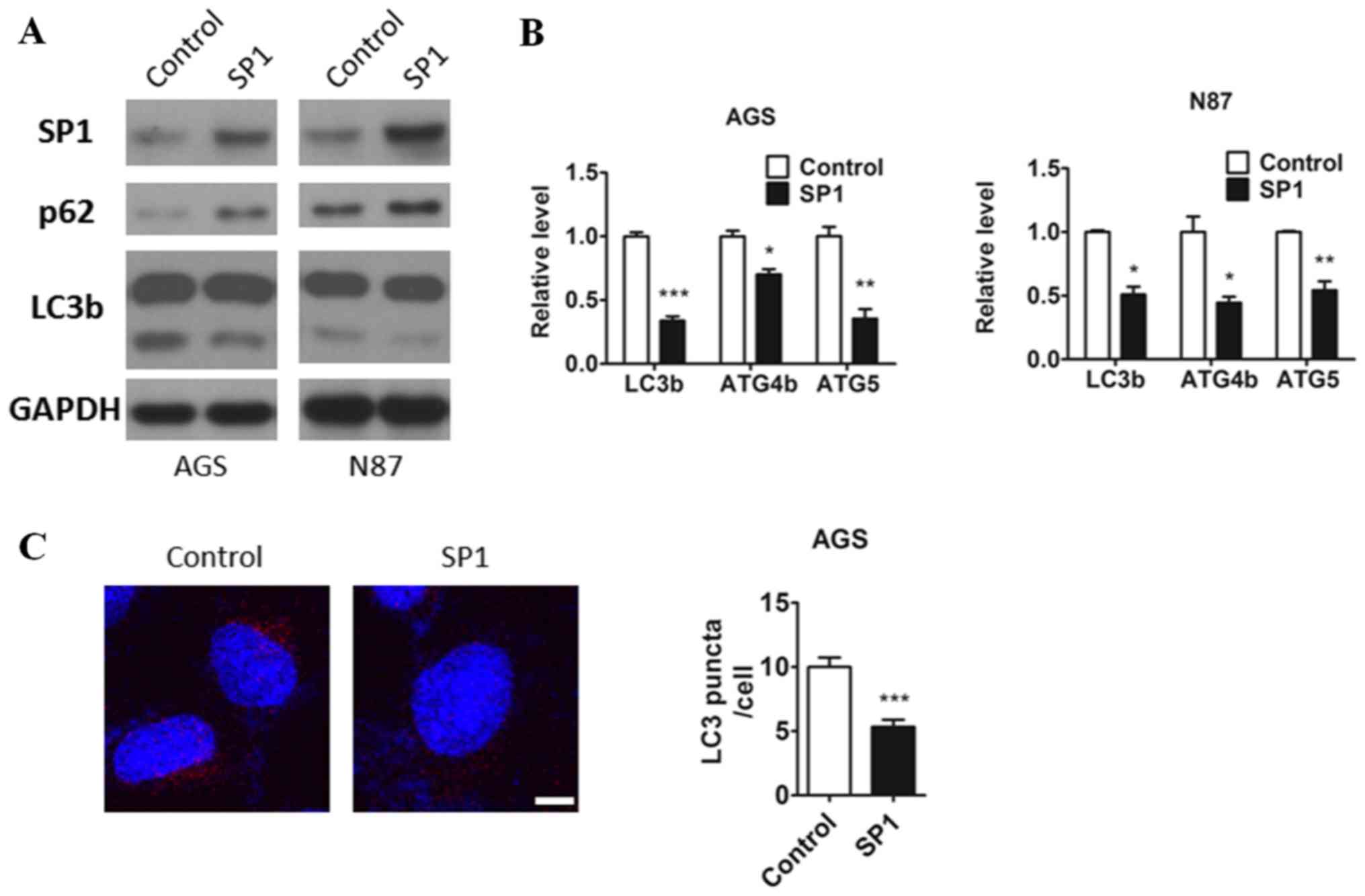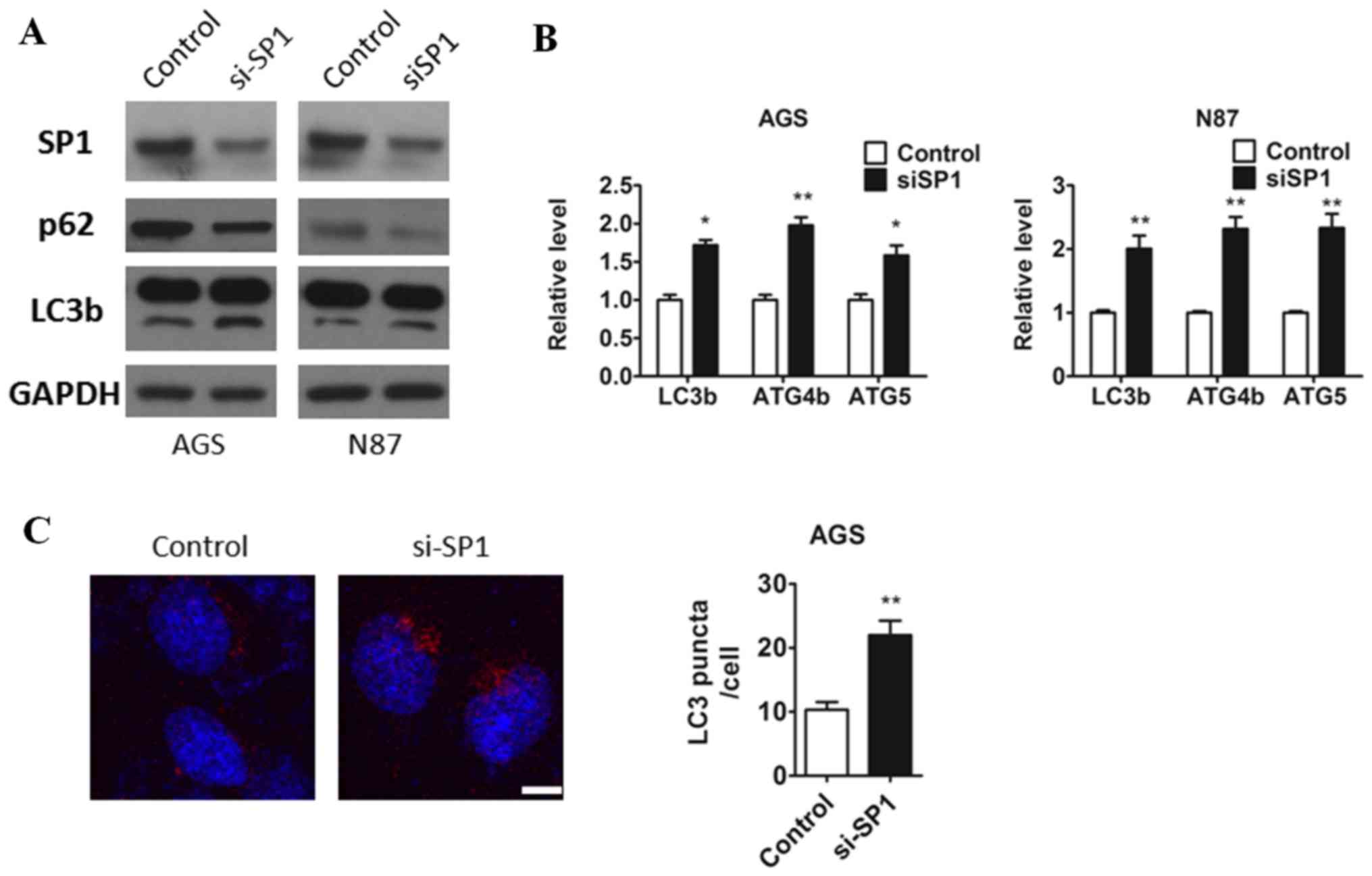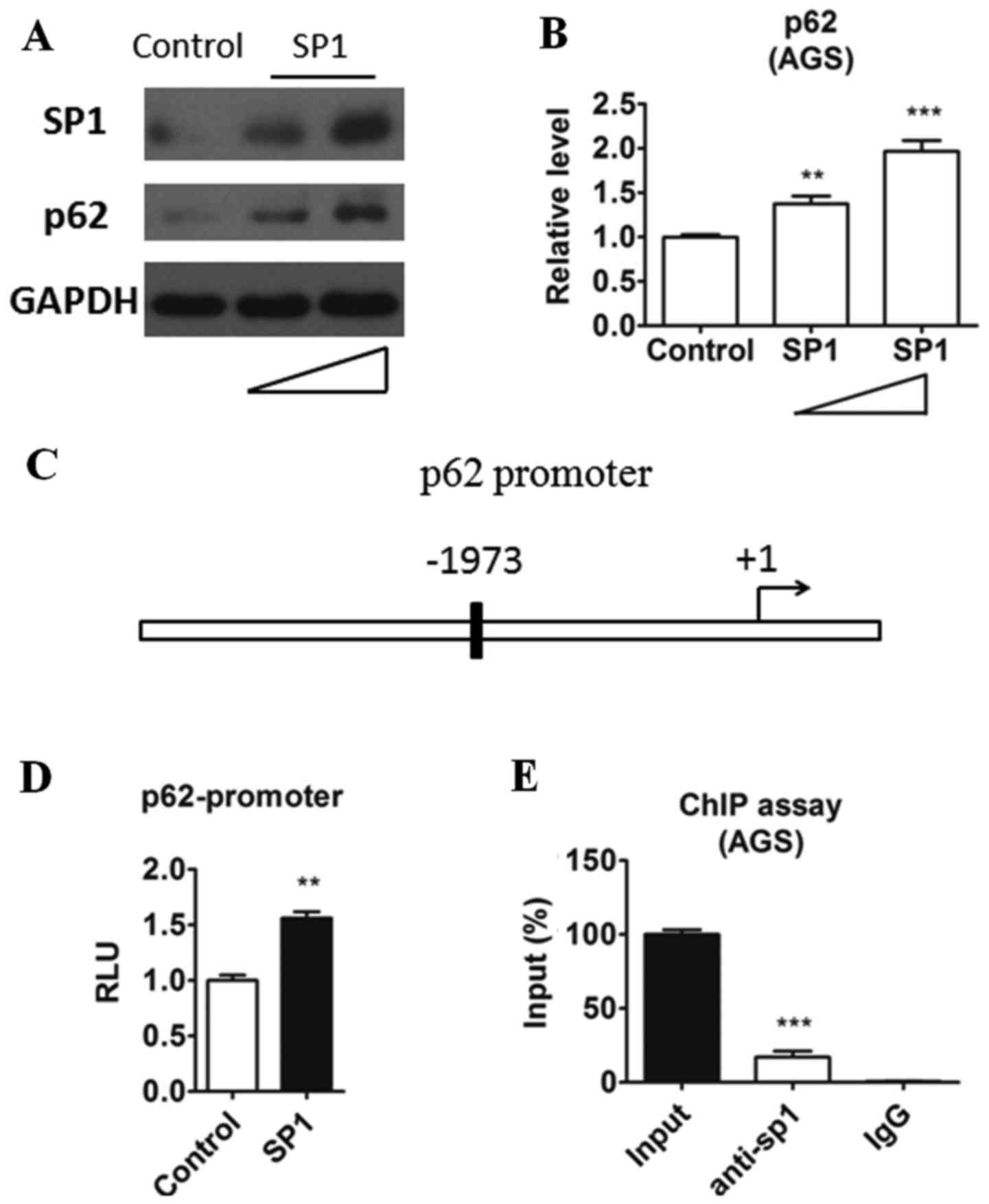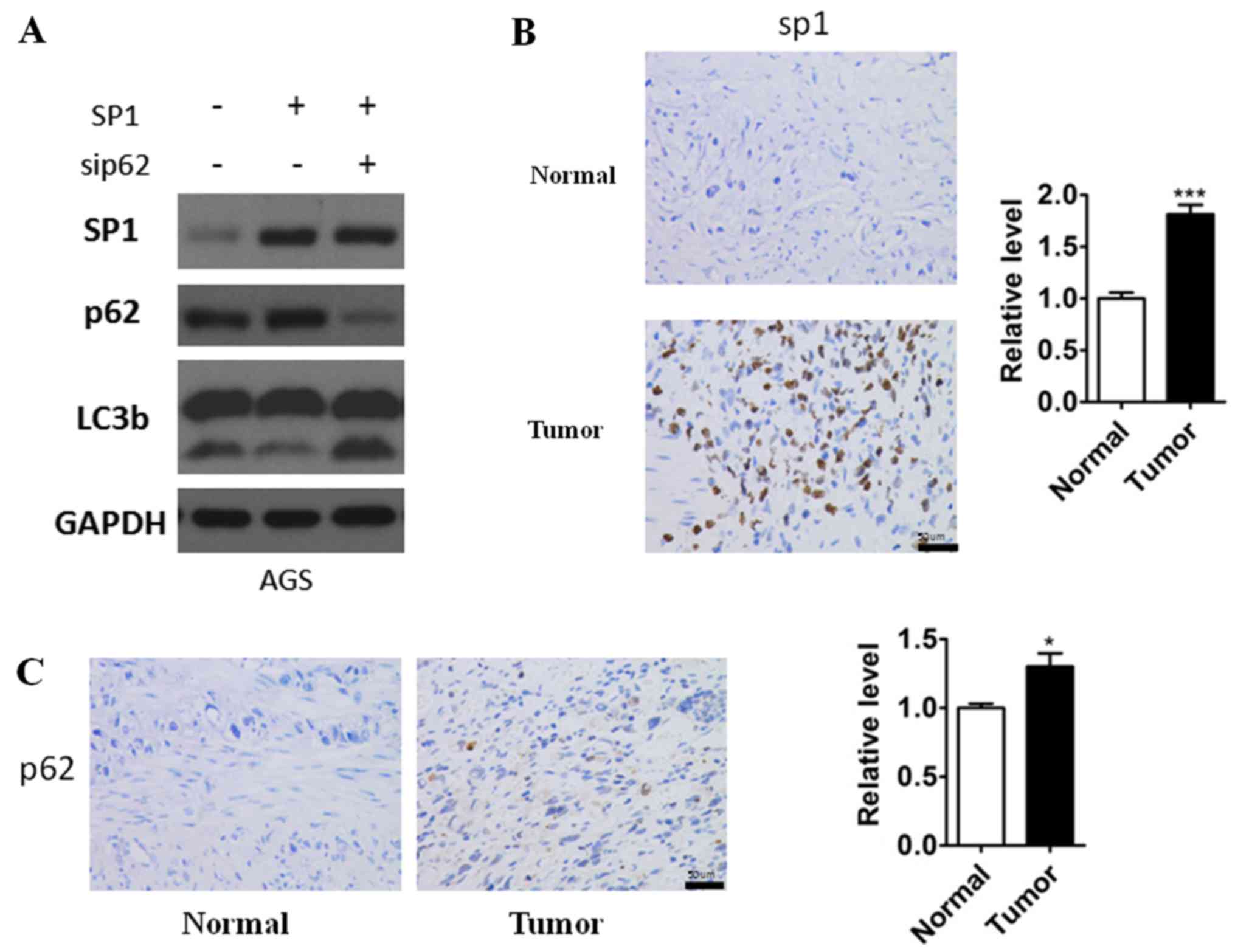SP1 reduces autophagic flux through activating p62 in gastric cancer cells
- Authors:
- Published online on: January 9, 2018 https://doi.org/10.3892/mmr.2018.8400
- Pages: 4633-4638
Abstract
Introduction
Gastric cancer is one of the top three leading causes of cancer death in the United States and China (1). It is a multifactor disease with high prevalence risk which can be presence for several years before its symptoms develop and its clinical outcome is difficult to predict. The factors of both genetics and epigenetic are usual causes of gastric cancer progression and development (2,3), however the underlying molecular mechanism is still unclear.
Macroautophagy (hereafter referred to as autophagy) is a homeostatic process involved in turnover of long-lived proteins and whole organelles by lysosomal activity that eliminates supernumerary or damaged organelle (4–6). It has been widely accepted that appropriate autophagic flux had beneficial effect on reducing the risk for diseases, especially in cancer (7). In general, autophagy is a survival mechanism induced in adverse environment. However, autophagy deficiency also lead to the tumors malignancy degree increased, gastric cancer included (8). Moreover, gastric carcinogenesis could be inhibited through autophagy induction (9,10). Due to the pivotal role of autophagy in gastric cancer progression, the key player autophagic adaptation has been considered as drug target for gastric cancer prevention and management.
SP1 is a zinc finger transcription factor belongs to the SP1 multigene family (SP2, SP3 and SP4), which plays an important role in development but also play a role in cancers (11). SP1 regulates target gene transcription by binding to their promoter contain GC boxes (12,13). Unique SP1 expression has been observed in malignant gastric tissues, and proven to have a close correlation with insulin-like growth factor I receptor (IGF1R) expression in gastric cancer (14–16). Besides that, dysregulated SP1 expression may contributed to the growth and metastasis of gastric cancer and can be a potential therapeutic target. However, little was known about how SP1 function in autophagy of gastric cancer.
In our study, we found that overexpression of SP1 decreased the autophagic flux in gastric cancer cells, whereas SP1 deficiency induces autophagy of cancer cells. Intriguingly, we observed SP1 could enhance the expression level of p62, by directly binding to the promoter of p62. Additionally, we found that p62 expression levels were upregulated in gastric tissues specimens together with SP1 expression. Together, we provided evidence for a novel mechanism regulating autophagy in gastric cancer cells.
Materials and methods
Ethics statement
The human gastric specimens were obtained during surgery from patients at the Department of General Surgery, The Second Hospital of Wenzhou Medical University. All the procedures were reviewed and approved by the Ethics Committee of The Second Hospital of Wenzhou Medical University (L-2016-27), and informed consent was obtained from all patients.
Cell culture and transfection
Human gastric cancer cells AGS and N87 (ATCC, Manassas, VA, USA) were culture in Dulbecco's modified Eagle's medium (DMEM) supplemented with 10% FBS, 1 mM glutamine, 100 U/ml penicillin, and 100 mg/ml streptomycin. Transfection was performed using Lipofectamine 2000 according to the instructions.
Plasmid and luciferase assay
For construction luciferase reporter plasmids, the promoter fragment of p62 was amplified from human genome cDNA and inserted into PGL3-basic vector. SP1, control plasmids, and p62 siRNA oligo were all purchased from Genechem (Shanghai, China).
AGS cells were planted in a 48-well plate and co-transfected with SP1 plasmid or control, pRL-TK and pGL3-p62-promoter. Forty-eight hours after transfection, cells were lysed and relative luciferase activity was analyzed with the Dual Luciferase Reporter Assay System on a luminometer (both from Promega, Madison, WI, USA).
Chromatin immunoprecipitation assay
Chromatin immunoprecipitation assay was performed as previously described by using Magna ChIP™ kit (Millipore, Billerica, MA, USA) (17). In brief, AGS cells were transfected with SP1 plasmids for 48 h, then chromatin was immunoprecipitated using anti-SP1 antibody (ab13370; Abcam, Cambridge, UK) at dilution 1:10. RT-PCR was performed to determine SP1 binding site. ChIP primer sequences are provided: Forward, GGCAGGTGCAGCACGTGC and reverse, TCAGAAAGGCAGGCGCTGC.
Immunofluorescence staining
AGS cells were seeded into 12-well plate, then transfected with plasmids. After 48 h, the cells were fixed with cold methanol and permeabilized with 1% Triton X-100 in PBS for 15 min. Anti-LC3b antibody (3868s, 1:200; Cell Signaling Technology, Inc., Danvers, MA, USA) was placed in PBS at 4°C overnight, following by incubation with Alexa Fluor 594 (CA11012s, 1:1,000; Invitrogen Life Technologies, Carlsbad, CA, USA) for 1 h at room temperature. The nucleic were stained using DAPI (C1005, 1:1,000; Beyotime Institute of Biotechnology, Haimen, China) for 3 min at room temperatuire. Finally, cell images were taken using a microscope (Olympus BX61; Olympus, Tokyo, Japan), then the LC3b-positive cells were calculated.
Real-time PCR
RNA was isolated using TRIzol reagent from cells, 500 ng of RNA was reverse-transcribed into cDNA using the RT system by PrimeScript RT reagent kit (RR037A; Takara). Real-time PCR which contain 4.6 µl CDNA, 5 µl SYBR Green (4887352001; Roche Diagnostics, Basel, Switzerland) and 0.4 µl primers was performed on ABI 7500 Fast Real Time PCR system. The following primers were used in this study: GAPDH forward, CTGGGCTACACTGAGCACC and reverse, AAGTGGTCGTTGAGGGCAATG; LC3b forward, GATGTCCGACTTATTCGAGAGC and reverse, TTGAGCTGTAAGCGCCTTCTA; ATG4b forward, ATGGACGCAGCTACTCTGAC and reverse, TTTTCTACCCAGTATCCAAACGG; ATG5 forward, AAAGATGTGCTTCGAGATGTGT and reverse, CACTTTGTCAGTTACCAACGTCA; p62 forward, GCACCCCAATGTGATCTGC and reverse, CGCTACACAAGTCGTAGTCTGG.
Western blotting
Cells were lysed in RIPA lysis buffer containing 10 mM Tris-HCl (pH 7.5), 1% SDS, 1 mM Na3VO4, 10 mM NaF and protease inhibitor cocktail (4693132001; Roche Diagnostics). Protein samples (20 µg) were subjected to immunoblotting, resolved on SDS-PAGE with 80 V, transferred onto nitrocellulose membranes with 300 mA for 3 h and blocked by 5% skim milk then probed with the various antibodies at 4°C overnight. Second day, the membranes washed with TBST buffer and probed with second antibodies which diluted with 5% skim milk at 1:1,500. Detection was performed by measuring the chemiluminescent signal as assayed by SuperSignal Ultra. SDS-PAGE (15%) for LC3b and 10% SDS-PAGE for other protein. Antibodies anti-SP1 (9389s, 1:1,000; Cell Signalling Technology, Inc.), anti-p62 (610833, 1:1,000; BD Biosciences, Franklin Lakes, NJ, USA), anti-LC3b (3868s, 1:1,000; Cell Signalling Technology, Inc.), GAPDH (1:5,000; Sigma-Aldrich; Merck KGaA, Darmstadt, Germany) diluted with 5% BSA were used for western blotting.
Immunohistochemistry analysis
A representative formalin-fixed paraffin-embedded tissue block was chosen from the 10 gastric cancer tissues and 17 normal gastric tissues. Sections mounted on poly-L-lysine-coated slide were incubated for 30 min at 60°C, deparaffinised by standard methods, and placed in 0.05 m Tris-HCI buffer, pH 7.2. Antigen retrieval was performed for 20 min in 10 mm sodium citrate buffer (pH 6.0) heated at 95°C in a steamer, followed by cooling for 20 min. After blocking endogenous peroxidase activity with 0.3% aqueous hydrogen peroxide for 5 min, the primary polyclonal anti-sp1 and anti-p62 antibody was incubated with the sections at a final dilution of 2 µg/ml for 30 min. The relative level was quantified by Image-Pro Plus. The distribution of immunolabelling was determined from a minimum of three representative high-power (×400 magnification) fields and categorised into three groups: 0%, negative; 1–25%, focal; and 26–100%, diffuse.
Statistical analysis
All results are represented as mean ± SEM from three independent experiments at least. Student's t-test was used to analyze the differences in mean values between two groups by GraphPad Prism 5.0 (GraphPad Software, Inc., La Jolla, CA, USA). P<0.05 was considered to indicate a statistically significant difference.
Results
Overexpression of SP1 inhibits autophagy in gastric cancer
To explore a potential role of SP1 in gastric cancer, we first overexpressed SP1 in two human gastric cancer cell lines, AGS and N87. Interestingly, we observed decreased protein level of autophagy marker LC3b and increased protein level of p62, along with the increase of SP1expression (Fig. 1A). Many studies have proved that those ATG genes expression promoted autophagy. LC3B localizes to the autophagosome membrane which was the key regulator involved in autophagosome formation (18). Atg5 protein could conjugate with Atg12 and Atg8 (LC3) and involved in the early stages of autophagosome formation (19). ATG4B (autophagin-1) shows the catalytic efficiency for cleaving the C terminus of LC3B (20). And p62 protein is an autophagy-specific substrate, the accumulation of p62 protein is always employed as a readout for autophagy impairment (21). Therefore, those genes are widely used as a markers of autophagic activity. To test whether SP1 alters the expression of the ATG genes (LC3b, ATG4b and ATG5) in gastric cancer cells, we used qRT-PCR and demonstrated that the mRNA expression of these genes were inhibited by the expression of SP1 in AGS and N87 cell lines (Fig. 1B). Also, decreased formation of autophagosomes labeled by LC3b antibody have been found in AGS cells expressing SP1 compared to the control (Fig. 1C). So these results indicated that SP1 may have a role in regulating autophagic pathways in gastric cancer cells.
Inbihition of SP1 induces autophagy in gastric cancer
As the data shown using SP1 overexpression, to confirm our hypothesis that sp1 plays a role in autophagic pathways and we respectively transfected control and si-sp1 oligos to both AGS and N87 cells by Lipo 2000 and 48 h after transfection, cells were lysed. As expected the protein level of sp1 was downregulated in both AGS and N87 cell (Fig. 1A). Consistently, we found that knockdown of SP1 in both AGS and N87 cells promoted the transition of LC3-I to LC3-II, and the protein level of p62 was diminished treated with si-SP1 oligos compared to the cells treated with control oligols (Fig. 2A). Furthermore, we also observed that SP1 deficiency led to an increasing of ATG genes (LC3b, ATG4b, ATG5) mRNA expression in both AGS and N87 cells (Fig. 2B). To further confirm the changes of autophagy accompany with sp1, AGS cells which were either transfected with a control or sp1 plasmid were isolated and immunofluorescence staining against LC3b antibody was applied and it was found that the inhibition of SP1 resulted in a clear increase in the autophagic flux (Fig. 2C). These results suggested that inhibition of the endogenous SP1 affected the process of autophagy.
SP1 promotes p62 expression at transcriptional level
According to the above results, we speculated that the expression level of p62 was mediated by sp1. The transcriptional activity of the p62 promoter was reported mediated by some transcription factors, such as NRF2 (22). However, whether SP1 could affect the expression of p62 and p62-mediated autophagy was unknown. To confirm our hypothesis, we isolated AGS cells which were either transfected with a control or sp1 plasmid and then quantified the protein level of p62. As shown in Fig. 3A and B, a dose-dependent protein level change of p62 in relation to SP1 was noticed. Overexpression of SP1 upregualted the p62 expression in both protein and mRNA levels intriguingly. Sp1 is a well-known transcriptional factor and regulate many genes expression through binding to their promoter. Therefore we speculated that sp1 may bind to the promoter of p62. By analyzing the sequence before the p62 transcription start site, we found a potential SP1-bingding element (GGGCGG) located upstream of p62 (Fig. 3C). Then we cloned this region into a luciferase reporter plasmid (WT) and evaluated the transcriptional activity when SP1 overexpression in AGS cells. As shown in Fig. 3D, SP1 could increase p62 promoter transcriptional activity. To evaluated whether SP1 could be recruited to the promoter of SP1, ChIP assay was performed in AGS cells. In agreement with the results in luciferase assay, we detected the recruitment of SP1 to the p62 promoter in ChIP assay (Fig. 3E). Taken together, these results indicated that SP1 may positively regulate p62 transcriptional activity by binding to its promoter in gastric cancer cells.
p62 is required for SP1-mediated autophagy inhibition
According to the above results, we found that sp1 could affect both the expression of p62 and the autophagy in gastric cancer cells. So we hypothesis that sp1 regulated autophagy is p62-dependent in gastric cancer cells. To confirm our hypothesis we extended our observation of SP1 regulatory network in AGS cells. Overexpression of SP1 increased p62 expression and led to downregulation of autophagic flux, while knockdown of p62 resulted in upregulation of LC3b-II even though with the presence of high SP1 expression (Fig. 4A). These results, taken together, indicated that SP1 promoted gastric cancer cells autophagy via activating p62, and in other words, p62 is required for SP1-mediated autophagy inhibition. In addition, to further confirm the results we had founded, the immunoreactivity of SP1 and p62 was analyzed in the gastric cell nuclear staining As shown in Fig. 4B and C we observed increasingly high sp1and p62 expression in gastric cancer specimens which was consistent to our study.
Discussion
Gastric cancer is one of the most popular and aggressive cancers worldwide. Although factors of both genetics and epigenetic are usual causes of gastric cancer progression and development (23), but the underlying molecular mechanism is still unclear. Autophagy plays a pivotal role in cancer progression. It is well accepted that appropriate autophagic flux is critical for cancer cells (24). Here we identified a novel regulatory mechanism that SP1 acted as a negative regulator of autophagy by activating p62 transcription in gastric cancer cells. The SP1-p62 axis may facilitate the tumorigenesis in gastric cancer.
SP1 is one of the general zinc finger transcription factor SP family, which plays an important role in cancer progression (25). It had been observed that the expression of SP1 was significantly elevated in gastric cancer specimens, and proved to have a closed correlation with patient survival (16). It is suggesting that SP1 signaling pathway may have a positive effect on gastric cancer progression and SP1 could be a prognostic marker for diagnosis of gastric cancer. However, little was known about how SP1 function in autophagy of gastric cancer. In the present study, we showed that SP1 could inhibit autophagy level in gastric cancer cells. SP1 deficiency led to a significant increase of autophagic flux in gastric cancer cells. Mechanistically, we found SP1 could increase the transcriptional activity of p62 through binding to the GC box located in the upstream of SP1. We further confirmed that by Luciferase assay and ChIP assay. Nonetheless, whether SP1 will function to affect the other aspects of gastric cancer remain further validation.
Alteration of autophagy-related genes was found in gastric cancer (26,27). It had been found that autophagy played a protective role at early stage of carcinogenesis (28,29). Autophagy deficiency led to accumulation of p62 in cells (30). The p62 protein is a structural component of the autophagesome (31,32). Accumulation of p62 can promote tumorigenesis. We here found that the p62 expression level was increase in SP1-positve gastric specimens further supporting the notion that SP1 could target p62 expression. Besides that, we also observed that SP1-mediated autophagy inhibition was blocked when elimination of p62, but the underlying mechanism is still not clear. The recent study of Mathew et al added a number of interesting twists to the role of p62 in cancer. These investigators showed that when cells with impairment in both apoptosis and autophagy were metabolically stressed, the accumulation of p62 led to enhanced tumorigenicity through an as yet undefned mechanism involving increased aneuploidy (30). These observations placed p62 as the missing link between defcient autophagy and increased tumorigenesis through the control of genome instability (33). An interesting feed-forward loop may contribute to this process. The increased ROS production in these cells may be responsible, at least in part, for the induction of p62 expression. p62 overexpression then contributes to additional ROS production as part of an amplifying loop, thereby promoting genome instability and autophagy. Meanwhile it is plausible that when cells are deprived of nutrients and oxygen, and p62 overexpression reaches a certain threshold level, NF-κB, which is a critical regulator of survivalis, inhibited by the mopping up of critical components of the NF-κB pathway into huge p62 aggregates. The dysregulated expression of SP1 resulted in hyperactivation of p62 may help the gastric cancer cells survival or growth under adverse condition.
In conclusion, our results provide evidence that SP1 inhibits gastric cancer cell autophagy via activating of p62. Further study will focus on the vivo effects of SP1 or p62 in gastric tissues. Our finding would provide a novel strategy for the treatment of gastric cancer.
Acknowledgements
This study was supported by the program of Zhejiang Provincial Natural Science Foundation (grant no. LY17H160054).
References
|
Torre LA, Bray F, Siegel RL, Ferlay J, Lortet-Tieulent J and Jemal A: Global cancer statistics, 2012. CA Cancer J Clin. 65:87–108. 2015. View Article : Google Scholar : PubMed/NCBI | |
|
Tahara E: Molecular aspects of invasion and metastasis of stomach cancer. Verh Dtsch Ges Pathol. 84:43–49. 2000.PubMed/NCBI | |
|
Chan AO, Luk JM, Hui WM and Lam SK: Molecular biology of gastric carcinoma: From laboratory to bedside. J Gastroenterol Hepatol. 14:1150–1160. 1999. View Article : Google Scholar : PubMed/NCBI | |
|
Eisenberg-Lerner A, Bialik S, Simon HU and Kimchi A: Life and death partners: Apoptosis, autophagy and the cross-talk between them. Cell Death Differ. 16:966–975. 2009. View Article : Google Scholar : PubMed/NCBI | |
|
Maiuri MC, Zalckvar E, Kimchi A and Kroemer G: Self-eating and self-killing: Crosstalk between autophagy and apoptosis. Nat Rev Mol Cell Biol. 8:741–752. 2007. View Article : Google Scholar : PubMed/NCBI | |
|
Shintani T and Klionsky DJ: Autophagy in health and disease: A double-edged sword. Science. 306:990–995. 2004. View Article : Google Scholar : PubMed/NCBI | |
|
Choi AM, Ryter SW and Levine B: Autophagy in human health and disease. N Engl J Med. 368:1845–1846. 2013. View Article : Google Scholar : PubMed/NCBI | |
|
Cheng HY, Zhang YN, Wu QL, Sun XM, Sun JR and Huang X: Expression of beclin 1, an autophagy-related protein, in human cervical carcinoma and its clinical significance. Eur J Gynaecol Oncol. 33:15–20. 2012.PubMed/NCBI | |
|
Wang K, Liu R, Li J, Mao J, Lei Y, Wu J, Zeng J, Zhang T, Wu H, Chen L, et al: Quercetin induces protective autophagy in gastric cancer cells: Involvement of Akt-mTOR- and hypoxia-induced factor 1α-mediated signaling. Autophagy. 7:966–978. 2011. View Article : Google Scholar : PubMed/NCBI | |
|
Tu SP, Quante M, Bhagat G, Takaishi S, Cui G, Yang XD, Muthuplani S, Shibata W, Fox JG, Pritchard DM and Wang TC: IFN-γ inhibits gastric carcinogenesis by inducing epithelial cell autophagy and T-cell apoptosis. Cancer Res. 71:4247–4259. 2011. View Article : Google Scholar : PubMed/NCBI | |
|
Suske G: The Sp-family of transcription factors. Gene. 238:291–300. 1999. View Article : Google Scholar : PubMed/NCBI | |
|
Hagen G, Dennig J, Preiss A, Beato M and Suske G: Functional analyses of the transcription factor Sp4 reveal properties distinct from Sp1 and Sp3. J Biol Chem. 270:24989–24994. 1995. View Article : Google Scholar : PubMed/NCBI | |
|
Shi Q, Le X, Abbruzzese JL, Peng Z, Qian CN, Tang H, Xiong Q, Wang B, Li XC and Xie K: Constitutive Sp1 activity is essential for differential constitutive expression of vascular endothelial growth factor in human pancreatic adenocarcinoma. Cancer Res. 61:4143–4154. 2001.PubMed/NCBI | |
|
Kanai M, Wei D, Li Q, Jia Z, Ajani J, Le X, Yao J and Xie K: Loss of Krüppel-like factor 4 expression contributes to Sp1 overexpression and human gastric cancer development and progression. Clin Cancer Res. 12:6395–6402. 2006. View Article : Google Scholar : PubMed/NCBI | |
|
Jiang Y, Wang L, Gong W, Wei D, Le X, Yao J, Ajani J, Abbruzzese JL, Huang S and Xie K: A high expression level of insulin-like growth factor I receptor is associated with increased expression of transcription factor Sp1 and regional lymph node metastasis of human gastric cancer. Clin Exp Metastasis. 21:755–764. 2004. View Article : Google Scholar : PubMed/NCBI | |
|
Wang L, Wei D, Huang S, Peng Z, Le X, Wu TT, Yao J, Ajani J and Xie K: Transcription factor Sp1 expression is a significant predictor of survival in human gastric cancer. Clin Cancer Res. 9:6371–6380. 2003.PubMed/NCBI | |
|
Martucci NM, Rea I, Ruggiero I, Terracciano M, De Stefano L, Migliaccio N, Palmieri C, Scala G, Arcari P, Rendina I and Lamberti A: A new strategy for label-free detection of lymphoma cancer cells. Biomed Opt Express. 6:1353–1362. 2015. View Article : Google Scholar : PubMed/NCBI | |
|
Kabeya Y, Mizushima N, Ueno T, Yamamoto A, Kirisako T, Noda T, Kominami E, Ohsumi Y and Yoshimori T: LC3, a mammalian homologue of yeast Apg8p, is localized in autophagosome membranes after processing. EMBO J. 19:5720–5728. 2000. View Article : Google Scholar : PubMed/NCBI | |
|
Mizushima N, Ohsumi Y and Yoshimori T: Autophagosome formation in mammalian cells. Cell Struct Funct. 27:421–429. 2002. View Article : Google Scholar : PubMed/NCBI | |
|
Yang Z, Wilkie-Grantham RP, Yanagi T, Shu CW, Matsuzawa S and Reed JC: ATG4B (autophagin-1) phosphorylation modulates autophagy. J Biol Chem. 290:26549–26561. 2015. View Article : Google Scholar : PubMed/NCBI | |
|
Klionsky DJ, Abdalla FC, Abeliovich H, Abraham RT, Acevedo-Arozena A, Adeli K, Agholme L, Agnello M, Agostinis P, Aguirre-Ghiso JA, et al: Guidelines for the use and interpretation of assays for monitoring autophagy. Autophagy. 8:445–544. 2012. View Article : Google Scholar : PubMed/NCBI | |
|
Jain A, Lamark T, Sjøttem E, Larsen KB, Awuh JA, Øvervatn A, McMahon M, Hayes JD and Johansen T: p62/SQSTM1 is a target gene for transcription factor NRF2 and creates a positive feedback loop by inducing antioxidant response element-driven gene transcription. J Biol Chem. 285:22576–22591. 2010. View Article : Google Scholar : PubMed/NCBI | |
|
Parkin DM, Pisani P and Ferlay J: Estimates of the worldwide incidence of 25 major cancers in 1990. Int J Cancer. 80:827–841. 1999. View Article : Google Scholar : PubMed/NCBI | |
|
Levine B: Cell biology: Autophagy and cancer. Nature. 446:745–747. 2007. View Article : Google Scholar : PubMed/NCBI | |
|
Hirose T and Horvitz HR: An Sp1 transcription factor coordinates caspase-dependent and -independent apoptotic pathways. Nature. 500:354–358. 2013. View Article : Google Scholar : PubMed/NCBI | |
|
Zhao Z, Han F, Yang S, Wu J and Zhan W: Oxamate-mediated inhibition of lactate dehydrogenase induces protective autophagy in gastric cancer cells: Involvement of the Akt-mTOR signaling pathway. Cancer Lett. 358:17–26. 2015. View Article : Google Scholar : PubMed/NCBI | |
|
Liu D, Gao M and Zhao S: Autophagy as a novel strategy for treatment of gastric cancer: A hypothesis. Med Sci Monit. 19:794–796. 2013. View Article : Google Scholar : PubMed/NCBI | |
|
Lee HW, Jang KS, Choi HJ, Jo A, Cheong JH and Chun KH: Celastrol inhibits gastric cancer growth by induction of apoptosis and autophagy. BMB Rep. 47:697–702. 2014. View Article : Google Scholar : PubMed/NCBI | |
|
Ge J and Chen Z, Huang J, Chen J, Yuan W, Deng Z and Chen Z: Upregulation of autophagy-related gene-5 (ATG-5) is associated with chemoresistance in human gastric cancer. PLoS One. 9:e1102932014. View Article : Google Scholar : PubMed/NCBI | |
|
Mathew R, Karp CM, Beaudoin B, Vuong N, Chen G, Chen HY, Bray K, Reddy A, Bhanot G, Gelinas C, et al: Autophagy suppresses tumorigenesis through elimination of p62. Cell. 137:1062–1075. 2009. View Article : Google Scholar : PubMed/NCBI | |
|
Bjørkøy G, Lamark T, Brech A, Outzen H, Perander M, Overvatn A, Stenmark H and Johansen T: p62/SQSTM1 forms protein aggregates degraded by autophagy and has a protective effect on huntingtin-induced cell death. J Cell Biol. 171:603–614. 2005. View Article : Google Scholar : PubMed/NCBI | |
|
Ichimura Y, Kumanomidou T, Sou YS, Mizushima T, Ezaki J, Ueno T, Kominami E, Yamane T, Tanaka K and Komatsu M: Structural basis for sorting mechanism of p62 in selective autophagy. J Biol Chem. 283:22847–22857. 2008. View Article : Google Scholar : PubMed/NCBI | |
|
Mathew R, Kongara S, Beaudoin B, Karp CM, Bray K, Degenhardt K, Chen G, Jin S and White E: Autophagy suppresses tumor progression by limiting chromosomal instability. Genes Dev. 21:1367–1381. 2007. View Article : Google Scholar : PubMed/NCBI |













